Michigan State fans had a great weekend. Not only did the Spartans beat a highly-ranked Michigan Wolverines squad, but in doing so, Michigan State almost certainly secured a bid to the program’s 23rd consecutive NCAA Tournament. Barring a miracle run by the Duke Blue Devils in the ACC Tournament, in two year MSU might just own the second longest streak in history, second only to Kansas’ current record of 30 (and counting).
That said, the Spartans did still finish below .500 in conference play. By that measure, this is officially Tom Izzo’s worst team on record. But, as the old saying goes, happiness is the difference between expectation and reality. Our collective spirits were so low at the beginning of February that the run over the past few weeks was as exciting and satisfying as any run to the Final Four, and likely more challenging.
What can I say? These are certainly strange times that we are living in.
But the fact remains that at least for the regular season, based on win and losses, this MSU team struggled. In order to try to understand how and why those numbers are not better, I wanted to take a deep dive into the numbers, starting with Kenpom efficiency data.
The Kenpom Scatter Plot
Throughout the Big Ten regular season, I have been generating a scatter plot which compares various teams based on their adjusted offensive and defensive efficiency. These efficiencies are a measure of the number of points a team scores and allows per 100 possessions, averaged over the entire season.
Figure 1 below shows this scatter plot as it stands at the end of the regular season, and it contains several different sets of teams for comparison. The green line shows the trajectory of MSU’s season over time, with MSU’s current position shown by the larger, labeled green dot. The slightly smaller green dots represent the stats of previous Tom Izzo teams.
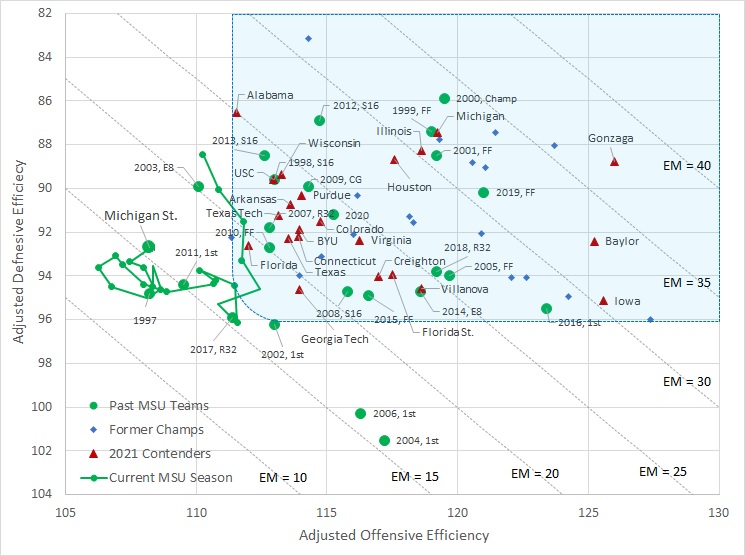
Figure 1: Kenpom adjusted efficiency scatter plot as of March 9
The small blue unlabeled diamonds are previous NCAA champions, dating back to 2002. These teams collectively define the boundaries of the blue shaded “championship zone.” Included within that zone are the 22 current teams whose profiles are consistent with past champions, including Gonzaga, Baylor, Michigan, Illinois, Houston, Iowa, Wisconsin and Purdue.
The Spartans are currently well outside of the championship zone. Other notable teams that also reside outside of this zone include Ohio State, San Diego State, Kansas, Tennessee, and West Virginia.
At the beginning of the year, Kenpom estimated that MSU would be a fairly strong defensive team, with some offensive deficiencies. The starting point for the Spartans was with a profile similar to Coach Izzo’s 2003 team that made the Regional Final and the 2013 team that made the Sweet 16.
However, once the season started, the Spartans’ defensive efficiency began to fall. Then, starting right around the beginning of the year, it was MSU’s offense then suddenly started to degrade. For much of February, the Spartans’ profile most closely resembled Coach Izzo’s 1997 team that failed to make the NCAA Tournament at all.
But, over the last few games, MSU’s efficiency has improved a little, such that the Spartans are now resting close to the diagonal that represents an efficiency margin of +15.00, which is similar to the MSU teams from 2002, 2017, and 2011. Those teams all made the NCAA Tournament, but only the 2017 team won a game. The 2021 Spartans are better defensively than those three teams, but not as good offensively.
The Four Factors
In order to better understand the relative strengths and weaknesses of the 2021 team, it is helpful to dig deeper into several key basketball statistics. In general, there are four key factors that people who study basketball analytics say have the biggest impact on efficiency. These are typically referred to as “the four factors,” which include field goal percentage, rebounding, turnovers, and free throw rate.
Let’s take a look at how the 2021 Michigan State team compares to past MSU teams using each of there four factors in reverse order of importance, starting with free throw rate. Figure 2 make the first of these comparisons.
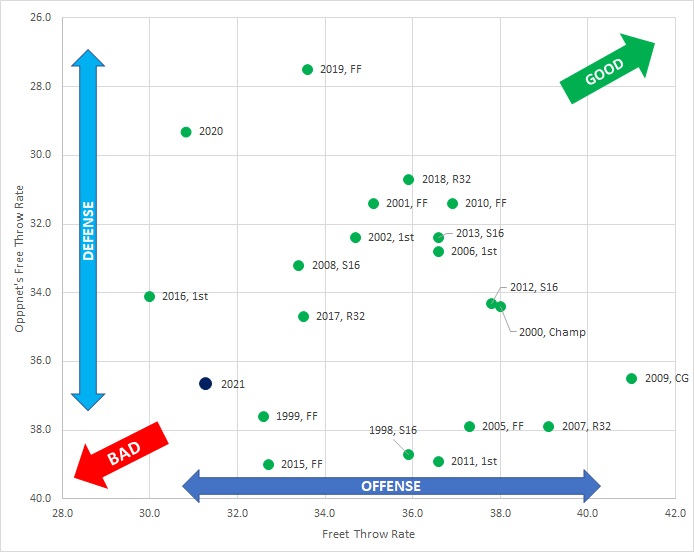
Figure 2: Comparison of free throw rate for the 2021 MSU team to other Tom Izzo coached teams
Each four factors graph will be formatted the same way. MSU’s offensive performance is plotted on the x-axis and MSU’s defensive performance will be plotted on the y-axis. The stats for the 2021 team are shown by a larger purple dot, while previous teams are marked with smaller, green dots. The numbers on the axis will either go in ascending or descending order such that a data point towards the upper right hand corner is good, while a data point in the left hand corner is bad.
The first of the four factors is free throw rate, which is traditionally defined as the number of made free throws per field goal attempt. Basically, on offense this measures how often a team gets to free line (and converts) and on defense it measures how often a team fouls.
Right off the bat, we have found an area where the 2021 team has struggled. The 2021 team, relatively speaking, does not get to the line very much, and they tend to foul a lot. That is a bad combination.
However, free throw rate is known to be the least important of the four factors, and as the figure shows, several of Coach Izzo’s best teams have also struggled in this area. Both the 1999 and 2015 Final Four teams fouled more than the 2021 team. Denzel Valentine’s 2016 team converted from the line less often. These three teams all had great seasons, despite the trouble at the charity stripe.
So, let’s move onto the next factor, rebounding, which is summarized in Figure 3.
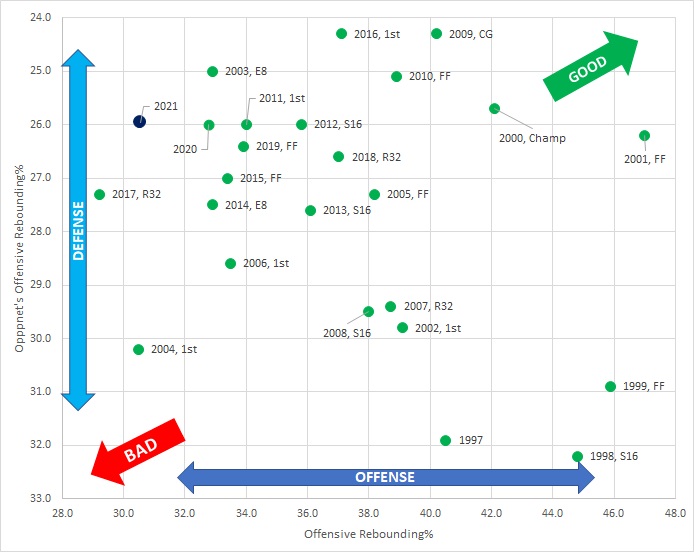
Figure 3: Comparison of the rebounding rate for the 2021 MSU team to other Tom Izzo coached teams
Rebounding rate is a little easy to understand. It is simply the percentage of missed shots that the team rebounds either on the offensive or defensive end of the floor. This is clearly a historical point of emphasis in the Michigan State program.
In 2021, rebounding seems to be a bit of a mixed bag. On the defensive end, this year’s team has a rate that is similar to the bulk of other Tom Izzo squads, if not a little better. The offensive glass, however, is a different story. The 2021 team is one of the worst offensive rebounding teams in the Tom Izzo era. It ranks right there with the 2004 team and the 2017 team, neither of which played in the second weekend of the NCAA Tournament.
Offensive rebounding does appear to be one of the key issues for this team. But, what about turnovers? That stat is summarized below in Figure 4.
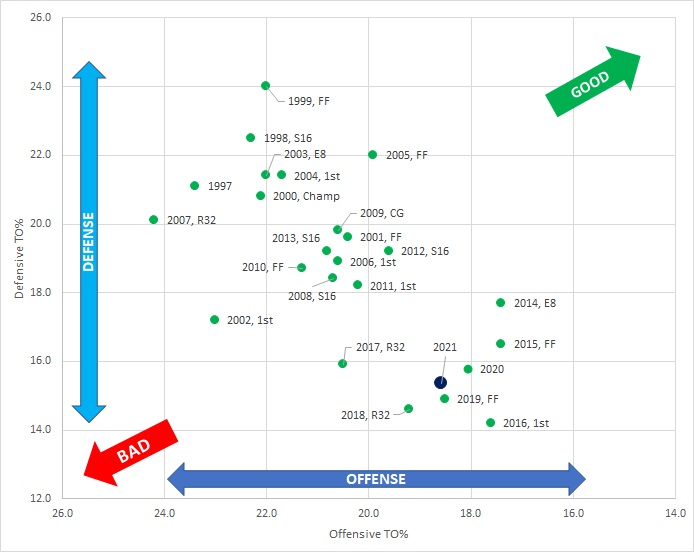
Figure 4: Comparison of turnover rate for the 2021 MSU team to other Tom Izzo coached teams
Turnover rate is also fairly straightforward. It is simply the percentage of possessions per game that end in a turnover, for any reason. Surprisingly, the 2021 squad actually does a fairly good job at taking care of the ball, relative to former MSU teams. This year’s team certainly does not create a lot of turnovers, but they are in good company in this category. Both the 2019 and 2020 teams had similar profiles.
Now, I should mention that none of these turnover numbers are elite. No Tom Izzo team has ever finished in the top 70 nationally in avoiding turnovers or in the top 90 of creating them. The key point is that this year’s team in not noticeably worse than other MSU teams that went on to have great years.
When it comes to basketball, the most important thing to do is to make shots and to prevent the other team from making shots. For this reason, it is the last of the four factors, effective field goal percentage, that is the most important. That metric is summarized below in Figure 5.
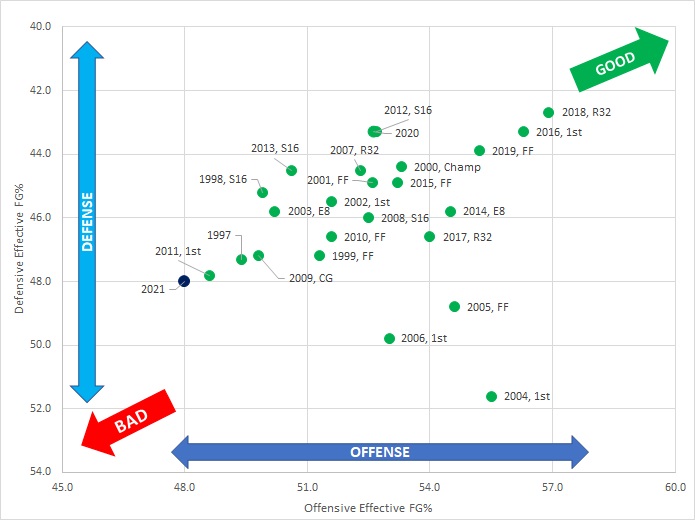
Figure 5: Comparison of effective field goal percentage for the 2021 MSU team to other Tom Izzo coached teams
Note that effective field goal percentage is a weighted average of the shooting percentage of both two-point and three-point shots. Just a glance at Figure 5 seems to provide the answer that we have been looking for. The main problem with the 2021 MSU team is that they are not a good shooting team, and the effective field goal percentage defense is not great either.
It is oddly appropriate that the two teams that most resemble the current 2021 team are the squads from 2011 and 1997, which were similarly inefficient as the current team. I will point out that the 2009 team that made it to the Championship Game at Ford Field was only slightly better of a shooting (and defending team). However, the 2009 team was very strong in the other three areas, and thus were able to overcome their, on average, poor shooting and poor field goal percentage defense.
In order to break the shooting woes down a bit more, I made two additional figures: one for two-shooting and one for three-point shooting. Figure 6 below shows the shooting from the long line.
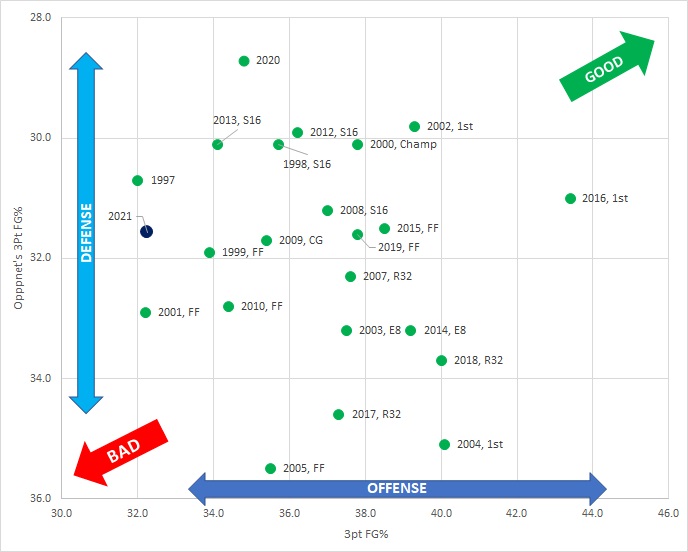
Figure 6: Comparison of the three-point field goal percentage for the 2021 MSU team to other Tom Izzo coached
As for three-point shooting, this is clearly a bad three-point shooting MSU team, but as the graph shows, other successful MSU teams, including three Final Four teams (1999, 2001, and 2010) are located in a similar part of the figure.
Furthermore, this year’s team is doing a good job at forcing opponents to shoot a relatively low percentage from three. In addition (though not shown here) MSU is also doing a good job limiting three-point attempts, relative to other Tom Izzo teams.
In other words, three-point shooting does not seem to be the main concern. How about two-point shooting? That is shown below in Figure 7.
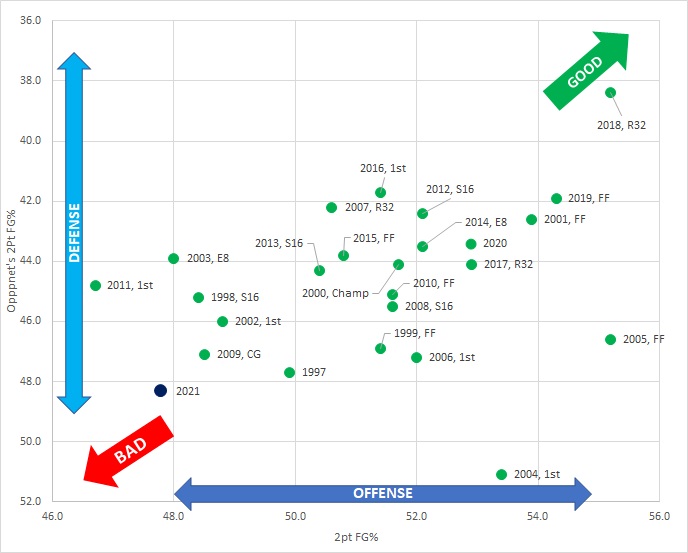
Figure 7: Comparison of the two-point field goal percentage for the 2021 MSU team to other Tom Izzo coached
It appears that we have zeroed in on the main problem. Both offensively and defensively, this MSU team has struggled to both score and defend inside the three-point line. The 2021 team is the second worst two-point shooting team in the Izzo era, only ahead of the 2011 team, and only the 2004 team played worse two-point defense.
That said, I will end with a bit of more positive news. One thing that we have learned about the 2021 team is that they are inconsistent and shooting is perhaps the key symptom of that problem. That said, MSU’s two-point offense correlates extremely well to wins and losses this year. The difference is stark.
In games this year where Michigan State shoots better than 45 percent from two, the Spartans are 14-2. In games where MSU shoots under 45 percent from two, the record is 1-9.
Note that the two losses with over 45 percent shooting were the loss at Northwestern, where the Wildcats shot the lights out, and the home game versus Purdue that MSU fumbled away in the final 30 seconds.
On the defensive side of the ball, the trend is similar but not quite as stark. When MSU has given up over 50 percent shooting from two, the Spartans’ record is 2-8. When MSU held opponents at or below that mark, the record was 13-3.
On some level, this is not shocking. If a team shoots better or defends better they should win more often right? While that is true, this kind of night-and-day result is fairly unique. I spot checked several other teams and I could not find one with nearly this level of contrast in the results.
If we think about the arc of this season, the Spartans seemed to hit a rut around Christmas. They were in the process of pulling out of that rut when the COVID pause happened, and then they played a compressed schedule in the final two weeks with tired legs. Certainly there were a lot of games in which their shooting and field goal defense may have been compromised by external factors.
Now that those factors have been largely removed, is it reasonable to expect that Michigan State might be able to shoot better after a little rest and postseason tune up practice? I think that this might be possible or even probable. If this does happen, what is MSU’s ceiling?
I am not sure about you, but I am excited to find out.
Go Green.
That said, the Spartans did still finish below .500 in conference play. By that measure, this is officially Tom Izzo’s worst team on record. But, as the old saying goes, happiness is the difference between expectation and reality. Our collective spirits were so low at the beginning of February that the run over the past few weeks was as exciting and satisfying as any run to the Final Four, and likely more challenging.
What can I say? These are certainly strange times that we are living in.
But the fact remains that at least for the regular season, based on win and losses, this MSU team struggled. In order to try to understand how and why those numbers are not better, I wanted to take a deep dive into the numbers, starting with Kenpom efficiency data.
The Kenpom Scatter Plot
Throughout the Big Ten regular season, I have been generating a scatter plot which compares various teams based on their adjusted offensive and defensive efficiency. These efficiencies are a measure of the number of points a team scores and allows per 100 possessions, averaged over the entire season.
Figure 1 below shows this scatter plot as it stands at the end of the regular season, and it contains several different sets of teams for comparison. The green line shows the trajectory of MSU’s season over time, with MSU’s current position shown by the larger, labeled green dot. The slightly smaller green dots represent the stats of previous Tom Izzo teams.

Figure 1: Kenpom adjusted efficiency scatter plot as of March 9
The small blue unlabeled diamonds are previous NCAA champions, dating back to 2002. These teams collectively define the boundaries of the blue shaded “championship zone.” Included within that zone are the 22 current teams whose profiles are consistent with past champions, including Gonzaga, Baylor, Michigan, Illinois, Houston, Iowa, Wisconsin and Purdue.
The Spartans are currently well outside of the championship zone. Other notable teams that also reside outside of this zone include Ohio State, San Diego State, Kansas, Tennessee, and West Virginia.
At the beginning of the year, Kenpom estimated that MSU would be a fairly strong defensive team, with some offensive deficiencies. The starting point for the Spartans was with a profile similar to Coach Izzo’s 2003 team that made the Regional Final and the 2013 team that made the Sweet 16.
However, once the season started, the Spartans’ defensive efficiency began to fall. Then, starting right around the beginning of the year, it was MSU’s offense then suddenly started to degrade. For much of February, the Spartans’ profile most closely resembled Coach Izzo’s 1997 team that failed to make the NCAA Tournament at all.
But, over the last few games, MSU’s efficiency has improved a little, such that the Spartans are now resting close to the diagonal that represents an efficiency margin of +15.00, which is similar to the MSU teams from 2002, 2017, and 2011. Those teams all made the NCAA Tournament, but only the 2017 team won a game. The 2021 Spartans are better defensively than those three teams, but not as good offensively.
The Four Factors
In order to better understand the relative strengths and weaknesses of the 2021 team, it is helpful to dig deeper into several key basketball statistics. In general, there are four key factors that people who study basketball analytics say have the biggest impact on efficiency. These are typically referred to as “the four factors,” which include field goal percentage, rebounding, turnovers, and free throw rate.
Let’s take a look at how the 2021 Michigan State team compares to past MSU teams using each of there four factors in reverse order of importance, starting with free throw rate. Figure 2 make the first of these comparisons.

Figure 2: Comparison of free throw rate for the 2021 MSU team to other Tom Izzo coached teams
Each four factors graph will be formatted the same way. MSU’s offensive performance is plotted on the x-axis and MSU’s defensive performance will be plotted on the y-axis. The stats for the 2021 team are shown by a larger purple dot, while previous teams are marked with smaller, green dots. The numbers on the axis will either go in ascending or descending order such that a data point towards the upper right hand corner is good, while a data point in the left hand corner is bad.
The first of the four factors is free throw rate, which is traditionally defined as the number of made free throws per field goal attempt. Basically, on offense this measures how often a team gets to free line (and converts) and on defense it measures how often a team fouls.
Right off the bat, we have found an area where the 2021 team has struggled. The 2021 team, relatively speaking, does not get to the line very much, and they tend to foul a lot. That is a bad combination.
However, free throw rate is known to be the least important of the four factors, and as the figure shows, several of Coach Izzo’s best teams have also struggled in this area. Both the 1999 and 2015 Final Four teams fouled more than the 2021 team. Denzel Valentine’s 2016 team converted from the line less often. These three teams all had great seasons, despite the trouble at the charity stripe.
So, let’s move onto the next factor, rebounding, which is summarized in Figure 3.

Figure 3: Comparison of the rebounding rate for the 2021 MSU team to other Tom Izzo coached teams
Rebounding rate is a little easy to understand. It is simply the percentage of missed shots that the team rebounds either on the offensive or defensive end of the floor. This is clearly a historical point of emphasis in the Michigan State program.
In 2021, rebounding seems to be a bit of a mixed bag. On the defensive end, this year’s team has a rate that is similar to the bulk of other Tom Izzo squads, if not a little better. The offensive glass, however, is a different story. The 2021 team is one of the worst offensive rebounding teams in the Tom Izzo era. It ranks right there with the 2004 team and the 2017 team, neither of which played in the second weekend of the NCAA Tournament.
Offensive rebounding does appear to be one of the key issues for this team. But, what about turnovers? That stat is summarized below in Figure 4.

Figure 4: Comparison of turnover rate for the 2021 MSU team to other Tom Izzo coached teams
Turnover rate is also fairly straightforward. It is simply the percentage of possessions per game that end in a turnover, for any reason. Surprisingly, the 2021 squad actually does a fairly good job at taking care of the ball, relative to former MSU teams. This year’s team certainly does not create a lot of turnovers, but they are in good company in this category. Both the 2019 and 2020 teams had similar profiles.
Now, I should mention that none of these turnover numbers are elite. No Tom Izzo team has ever finished in the top 70 nationally in avoiding turnovers or in the top 90 of creating them. The key point is that this year’s team in not noticeably worse than other MSU teams that went on to have great years.
When it comes to basketball, the most important thing to do is to make shots and to prevent the other team from making shots. For this reason, it is the last of the four factors, effective field goal percentage, that is the most important. That metric is summarized below in Figure 5.

Figure 5: Comparison of effective field goal percentage for the 2021 MSU team to other Tom Izzo coached teams
Note that effective field goal percentage is a weighted average of the shooting percentage of both two-point and three-point shots. Just a glance at Figure 5 seems to provide the answer that we have been looking for. The main problem with the 2021 MSU team is that they are not a good shooting team, and the effective field goal percentage defense is not great either.
It is oddly appropriate that the two teams that most resemble the current 2021 team are the squads from 2011 and 1997, which were similarly inefficient as the current team. I will point out that the 2009 team that made it to the Championship Game at Ford Field was only slightly better of a shooting (and defending team). However, the 2009 team was very strong in the other three areas, and thus were able to overcome their, on average, poor shooting and poor field goal percentage defense.
In order to break the shooting woes down a bit more, I made two additional figures: one for two-shooting and one for three-point shooting. Figure 6 below shows the shooting from the long line.

Figure 6: Comparison of the three-point field goal percentage for the 2021 MSU team to other Tom Izzo coached
As for three-point shooting, this is clearly a bad three-point shooting MSU team, but as the graph shows, other successful MSU teams, including three Final Four teams (1999, 2001, and 2010) are located in a similar part of the figure.
Furthermore, this year’s team is doing a good job at forcing opponents to shoot a relatively low percentage from three. In addition (though not shown here) MSU is also doing a good job limiting three-point attempts, relative to other Tom Izzo teams.
In other words, three-point shooting does not seem to be the main concern. How about two-point shooting? That is shown below in Figure 7.

Figure 7: Comparison of the two-point field goal percentage for the 2021 MSU team to other Tom Izzo coached
It appears that we have zeroed in on the main problem. Both offensively and defensively, this MSU team has struggled to both score and defend inside the three-point line. The 2021 team is the second worst two-point shooting team in the Izzo era, only ahead of the 2011 team, and only the 2004 team played worse two-point defense.
That said, I will end with a bit of more positive news. One thing that we have learned about the 2021 team is that they are inconsistent and shooting is perhaps the key symptom of that problem. That said, MSU’s two-point offense correlates extremely well to wins and losses this year. The difference is stark.
In games this year where Michigan State shoots better than 45 percent from two, the Spartans are 14-2. In games where MSU shoots under 45 percent from two, the record is 1-9.
Note that the two losses with over 45 percent shooting were the loss at Northwestern, where the Wildcats shot the lights out, and the home game versus Purdue that MSU fumbled away in the final 30 seconds.
On the defensive side of the ball, the trend is similar but not quite as stark. When MSU has given up over 50 percent shooting from two, the Spartans’ record is 2-8. When MSU held opponents at or below that mark, the record was 13-3.
On some level, this is not shocking. If a team shoots better or defends better they should win more often right? While that is true, this kind of night-and-day result is fairly unique. I spot checked several other teams and I could not find one with nearly this level of contrast in the results.
If we think about the arc of this season, the Spartans seemed to hit a rut around Christmas. They were in the process of pulling out of that rut when the COVID pause happened, and then they played a compressed schedule in the final two weeks with tired legs. Certainly there were a lot of games in which their shooting and field goal defense may have been compromised by external factors.
Now that those factors have been largely removed, is it reasonable to expect that Michigan State might be able to shoot better after a little rest and postseason tune up practice? I think that this might be possible or even probable. If this does happen, what is MSU’s ceiling?
I am not sure about you, but I am excited to find out.
Go Green.

